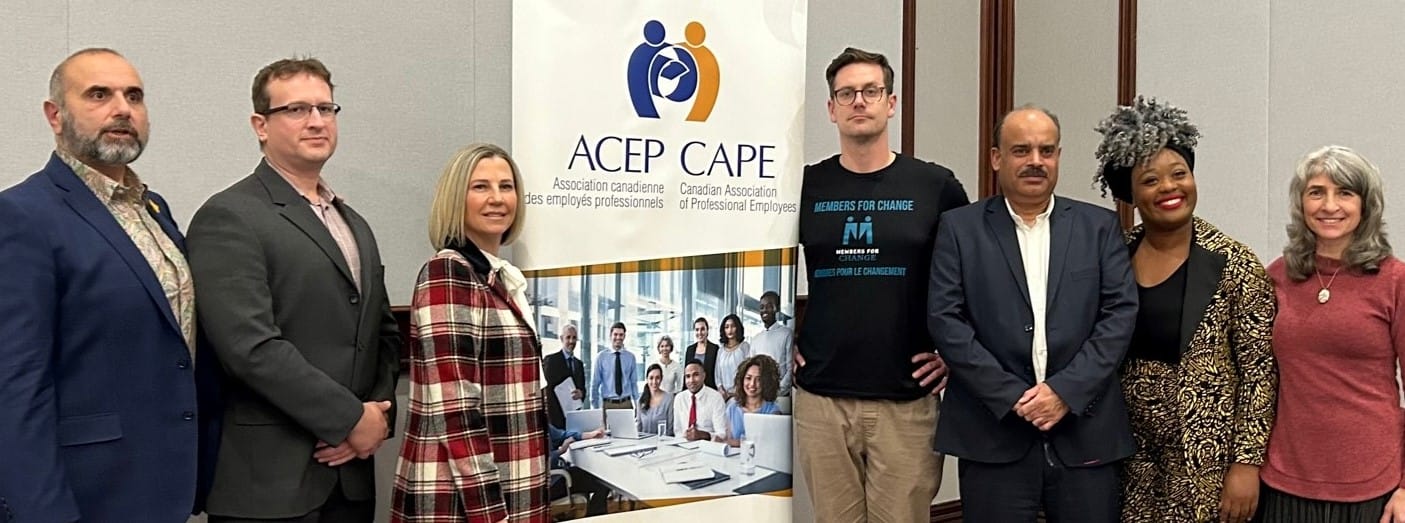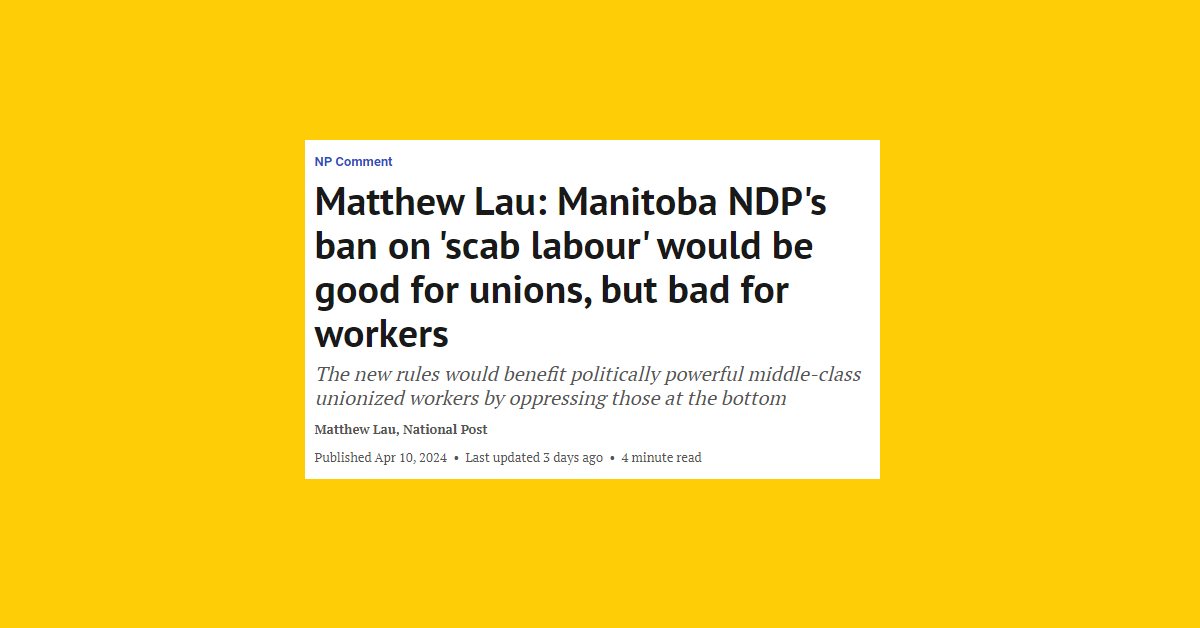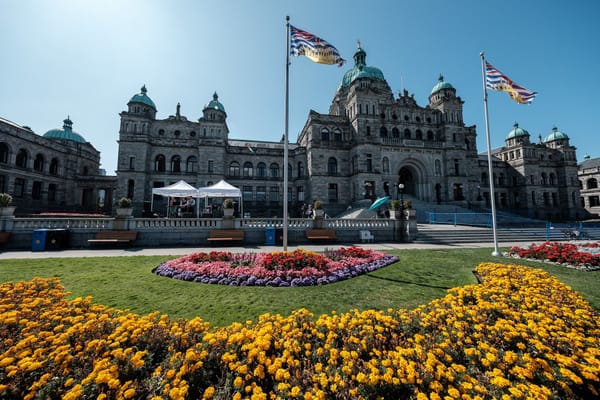
This week, I sat down with Nathan Prier, the newly elected president of the Canadian Association of Professional Employees (CAPE), a public sector union representing members across the federal public service.
Nathan and a slate of progressive candidates — Members for Change — recently won key leadership positions in CAPE, creating a unique opportunity to reform an important federal public sector union. As well, the Members for Change’s campaign offers important lessons for rank-and-file labour activists seeking to transform their unions.
Adam King: Let’s start by introducing Class Struggle readers to the Canadian Association of Professional Employees (CAPE). Who does CAPE represent? Tell us a little about the union’s recent history.
Nathan Prier: CAPE has a little more than 25,000 members. We’re one of the largest federal public service unions in Canada, but quite a bit smaller than the very largest union — the Public Service Alliance of Canada (PSAC).
We advocate on behalf of federal employees in a few classifications. The economics and social science services, or the “EC categories,” are the biggest bargaining units. These include policy analysts, economists and social scientists across most federal departments as well as the translation group. Our biggest classification group includes translators and interpreters — people who are critical for House of Commons committees. Then we also represent some employees from the Library of Parliament, and some employees from the office of the Parliamentary Budget Officer, as well as some of the civilian members from the RCMP.
We’re one of 17 federal public sector unions. The federal public sector labour landscape was in many ways designed by the employer, and so workers are fragmented into many unions. Our union came together in the early 2000s, when various other social scientist unions in that fragmented landscape merged into one union. CAPE actually had its 20th anniversary in 2023, but it’s a continuation from the social scientist’s union of the past.
AK: You were recently elected as CAPE’s new president, along with a slate of other candidates who won positions in the union leadership. The slate — Members for Change — campaigned on a platform of member engagement and reform. Tell us about Members for Change and why you folks thought it was time for change at CAPE.
NP: Our slate was elected with a large mandate. We had one of the biggest wins in the history of CAPE elections. The election still had fairly low turnout — about 10 to 11 per cent — but it was still a fairly large number for CAPE members and speaks to what our slate wanted to do, which is to increase member participation and ownership of the union.
Members for Change ran on the promise to build a more democratic and collaborative union, with the aim of winning bigger and delivering better results for our membership. We really wanted to pivot the union from a representation or service model to an organizing model where we can mobilize and organize our members and also train them to organize themselves, so that the rank-and-file can really steer the union in a substantial way.
CAPE’s been a pretty top heavy union in a lot of ways in the past, I think. We’d like to bring campaigns back to the union, and we’d like to bring those campaigns up from the shop floor and train people to be able to organize with their coworkers to win the things that they need.
We see ourselves as part of the larger public sector labour movement, and as part of the larger labour movement more broadly. We ran on greater union democracy — increasing the ways in which participatory mechanisms and transparency are built into the union’s DNA. For example, we want to have a delegated convention model where members of locals and members of equity groups send delegates to a larger policy conference.
Then we want to bring more things directly to the membership to vote on throughout the year, instead of just once at the annual general meeting. We didn’t feel like that was a particularly good way to have robust and continued debate about strategy.
Equity was another big part of our platform. Before, CAPE had one Equity Diversity Inclusion Committee, capped at five people. We felt this wasn’t dealing adequately with things like anti-Black racism in the federal public service. Black federal employees felt like they had to launch a class action lawsuit over hiring, promotion and racism in the workplace, feeling that the employer was completely dropping the ball on many fronts. We felt that we should have a Black caucus that’s helping to find these shop floor issues and advising our national executive. It could also be organizing members to help create well-structured demands and a winning strategy on issues of importance to equity-seeking members.
Last, we’re trying to pivot CAPE toward “social unionism” and away from “business unionism,” as we see it. It’s about building relationships with communities under attack and raising the floor of conditions of all our lives. On issues like housing and affordability, we see a role for our union.
AK: With federal workers fragmented across so many unions, are there common issues facing workers that could be centered?
NP: We see it as a big strategic initiative to build a common front, a united front with other unions to address the issues that are common to federal employees. That could be protecting or extending telework, or it could be fighting back against things like the Phoenix pay system debacle, or it could be protecting our members against future reckless initiatives like wild “workforce adjustments,” which is federal public servant language for job cuts.
We feel like there’s power in numbers here, and we need to start stitching together formalized joint campaigns with the other big unions. We need to build rank-and-file connections through a solidarity approach so members of all unions develop common campaigns in their specific workplaces.
We were inspired by the Front commun experience in Quebec, where nurses, teachers and people from different public sector unions made joint demands that they’d strategically set to amplify their power and have each other’s backs on key issues.
AK: Members for Change also grew out of an internal caucus inside the union — the Solidarity Caucus. This approach of organizing a reform caucus of rank-and-file members has long been a strategy to increase democratic participation and activism inside unions, but more recently it seems like union members are really using the strategy to build power to win leadership and reform unions. How did the work of the Solidarity Caucus contribute to Members for Change’s win?
NP: The Solidarity Caucus formed before the Members for Change platform, and then most of the Members for Change team eventually formed into a slate. The Solidarity Caucus was one of CAPE’s first rank-and-file caucuses.
The caucus formed not long before the election season got started during the PSAC strike, where CAPE had already committed to arbitration as a path for its members. Unlike a lot of other provincial labour relations schemes, in the federal public service unions can actually choose to go to arbitration before they even go into bargaining, which to me feels like an incredibly unstructured decision. Strike leverage is important, even if you don’t ultimately go on strike.
Because CAPE has often chosen to go to arbitration, it means that PSAC ends up pulling the weight for a lot of the other unions and raising the floor for other federal public service contracts. For example, the last PSAC strike dramatically improved our contract outcome. But during the strike, the Solidarity Caucus felt that the national office of CAPE wasn’t doing enough to contribute to PSAC’s effort. So, we organized picket line support across departments. There was rank-and-file cross pollination going on in a way that hadn’t happened in quite some time in the federal public sector.
CAPE is concentrated in the national capital region, but we had people joining pickets in Montreal, Toronto, Vancouver and many other places. In doing this, we had all of a sudden created the base of a caucus that had confidence that it could take solidarity into its own hands.
Out of this we designed what we called our membership principles, but which operated as a bit of a platform for what the Solidarity Caucus was all about, and a lot of those things ended up being reflected in the Members for Change platform. More grassroots level democracy for the rank-and-file. Social Unionism as a principle. Focusing on building solidarity and strategic power.
By the time of union election season, the Solidarity Caucus had about 250 members, which might not seem like that many people relative to our total membership, but was in fact a lot of members all having these discussions and organizing. The experience of organizing together in the Solidarity Caucus built many of the relationships and the trust necessary to say, ‘We will have each other’s back on a slate.’
It seems like a really basic thing, but saying that our union should be fighting to win and maximizing our power as workers is a big narrative shift from the type of business unionism that had defined CAPE for as long as I’ve been a member.
AK: In many unions, changes in leadership can be relatively orchestrated. Contested elections in some cases are even rare. Leaderships can become entrenched and elections end up looking more like coronations. Tell us about how Members for Change approached CAPE’s leadership election? How did you engage with members?
NP: We put together a few position papers, one of which was on reconciliation and CAPE’s relationship to Indigenous federal public servants, but also to Indigenous communities across the country. Another addressed our approach for pushing back against the current wave of transphobia that’s spreading across the country and in our workplaces.
We were trying to show how a social unionist approach could bring specific demands and campaign goals together. We held town halls. We held debates on Reddit.
But more than anything, we went out into every building where we have members and had one-on-one conversations. Members for Change was big on this. We had a lot of volunteers — about 50 — who signed up to go and leaflet, desk-to-desk, in every building where we had a presence to speak to as many CAPE members as possible.
We had very structured campaign pitches. We said, ‘We want to win telework and we want to build a common front with PSAC and with PIPSC [Professional Institute of the Public Service of Canada],’ the second largest federal public service union.
On telework, we wanted to be able to say to the employer that they don’t need to maintain the current level of commercial real estate. Those buildings in downtown Ottawa — an overwhelmingly government employment zone — could be used by community organizations, whether its housing or child care. We tried to connect our demands and work to the broader community around us. We were able to bring in some community partners too and managed to get endorsements from them.
AK: If we look at examples of reform movements winning leadership in unions, particularly from the United States (like in the Chicago Teachers Union or in the Teamsters or the United Auto Workers), these leadership changes have often been the prerequisite for important union bargaining victories. Do you folks see yourselves in a similar tradition of union reform?
NP: Yes, absolutely. We’re inspired by some of these major victories of rank-and-file caucuses. I think the UAW [United Auto Workers] wave of strikes in the U.S. over the summer was particularly inspiring to us.
But I also think there’s sometimes a gap between the reform caucus forming and then being able to seize leadership. It often depends on the type of elections unions hold: if they’re delegated conventions where only delegates are sent, that can lead to a political machine that really entrenches itself.
In CAPE, we have a direct membership vote for the leadership but there’s very low engagement in the union. So, I think just by getting out there and talking to people, we were able to flip a strong majority of voting members.
But in getting new people to vote, we were also trying to get our message out. We want to bring that direct organizing into how we run campaigns before we get into bargaining. Again, it’s about pivoting to an organizing model, which means structured training about how to have an organizing conversation, how to identify who the organic leadership is in your workplace and then to try to bring those people into a campaign that mobilizes workers.
Once we get into the next round of bargaining, we’re going to have to decide whether we’re going to arbitration again, or whether we’ll decide to take a different path. Pre-bargaining is going to involve a lot of rank-and-file mobilization. And that has to happen across unions, not just in CAPE.
AK: Now that you’ve assumed the leadership in CAPE, what are your plans for the union? New federal public sector collective agreements were signed last year, so bargaining is a ways off for now. What will CAPE’s work look like going forward?
NP: One of the major things our slate ran on — and that’s still important to a huge majority of our membership — is telework. With our employer being government, we have a lot of leverage to shift white-collar work to a model that doesn’t rely on us taking long commutes to half-empty offices with poor services, with all the climate impacts that go along with this.
We want to make sure we’ve got concrete demands around telework when we get to bargaining, but also that we start fighting on this issue right now through campaigns and workplace escalations. We’re hearing a lot from people around the country who moved to different cities during the pandemic and want to stay closer to their communities — Indigenous people, francophones working in different parts of Quebec. They’d like to maintain a more nationally-oriented workforce with a flexible telework policy.
As well, there is a section of our members — interpreters — whose health and safety has been absolutely disregarded by the employer. Many of these people are leaving the field in droves ever since the world went to Zoom and virtual meetings because of the sensitivity of some of the audio tools that they have to use. Hearing injuries that interpreters are having on the job from acoustic shock or long term strain have gone wildly unaddressed.
These workers are very hesitant to do things like work refusals because sometimes they’re performing work like interpreting a committee hearing on, say, a reconciliation report — not to mention that they’re often facing some of the most powerful people in the country during these meetings. So, we’d like to build a committee of interpreters to seriously raise this issue and address these injuries.
We’re also all thinking right now about the upcoming federal election, the planned austerity that’s already been put into place and the “workforce adjustment,” or the job cuts that could be coming, regardless of who wins the election. But seeing polls suggesting that there could be a strong Pierre Poilievre majority, and given the experience of the Stephen Harper government with its major cuts and attacks on public sector workers, we’re trying to build out a serious plan to prepare with the other unions right now. ‘If major cuts are planned, how do we prevent them?’
I think many Canadians have become used to a certain level of federal service delivery. But there’s been a lot of ‘fat trimming’ in the federal workforce over the last year. So, building out those relationships and fighting back against job cuts from a community perspective, not just within a labour relations framework is important.
Recent Class Struggle Issues
- February 19 | The Growing Popularity Of Right-To-Work Laws Is Troubling
- February 12 | It’s Time For Anti-Scab Legislation In Every Jurisdiction
- February 5 | Saskatchewan Teachers Fighting For Working And Learning Conditions
- January 22 | The Union Wage Premium Remains Strong Across Canada








Member discussion